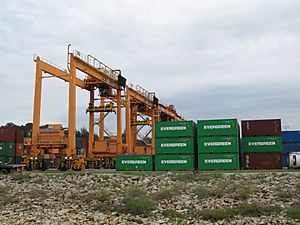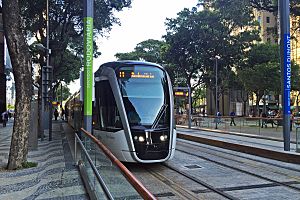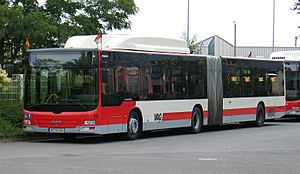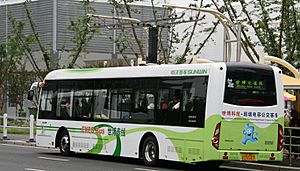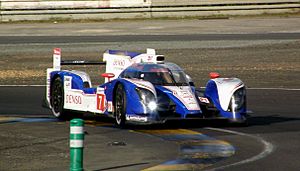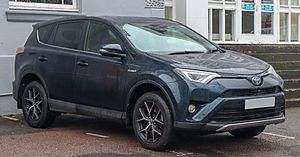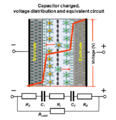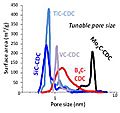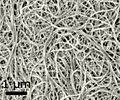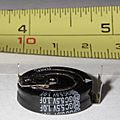Supercapacitor facts for kids
A supercapacitor is a special type of capacitor that is very good at storing and releasing energy quickly. Think of it like a super-fast battery! While regular batteries store a lot of energy and release it slowly, supercapacitors can store a good amount of energy and release it in a big burst.
Many people believe that in the future, electric cars might use supercapacitors. This could also mean that mobile phones would hold their charge better, so you wouldn't need to charge them as often.
Contents
What Are Supercapacitors Used For?
Supercapacitors are great when you need a lot of power for a short time. They can also be charged and discharged many, many times without wearing out, and they last a long time.
Everyday Uses
Powering Your Gadgets
Supercapacitors can help keep the power steady for things like laptop computers, GPS devices, portable media players, and other hand-held devices. They can also help photovoltaic systems (solar panels) provide a smooth power supply.
They are used in digital cameras to power the photographic flash. They can charge the flash much faster than batteries, sometimes in just 90 seconds! Some portable speakers also use supercapacitors for power.
Powering Tools
Imagine an electric screwdriver that charges in just 90 seconds! Some cordless screwdrivers use supercapacitors for energy storage. While they might not run as long as a battery-powered one, they charge super fast and keep most of their charge even after three months of not being used.
Helping the Power Grid
Supercapacitors can act like a buffer between big power users (like electric vehicle chargers) and the main power grid. They help smooth out sudden changes in power demand, making the grid work more efficiently.
Backup Power for Small Devices
Supercapacitors can provide backup power for important parts of computers, like RAM or micro-controllers. They can also be the only power source for things that don't need much energy, like smart meters that read your electricity usage.
They can also work with rechargeable batteries to make them last longer. Supercapacitors handle the quick, strong bursts of power needed, so the batteries only have to work during longer power outages. This is why Uninterruptible Power Supplies (UPS) sometimes use supercapacitors to keep computers running during short power cuts.
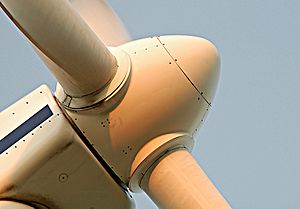
Supercapacitors also provide backup power for wind turbines. If the main power fails, they can still adjust the blades of the turbine to keep it safe.
Stabilizing Voltage
Supercapacitors can help keep the voltage steady on power lines. For example, when wind or solar power changes quickly (like when a cloud covers the sun), supercapacitors can instantly balance the power flow.
Storing Energy in Microgrids
Microgrids are small power systems, often using clean energy like solar or wind. Since these energy sources can change throughout the day, supercapacitors can store energy when there's a lot and release it quickly when needed. They work well with batteries to provide immediate power when demand is high.
Capturing Energy
Supercapacitors are good for storing energy collected from the environment, a process called energy harvesting. This means gathering energy from things like movement, light, or electromagnetic fields and turning it into electricity. For example, energy from radio waves can be stored in a supercapacitor to power small electronic circuits for many hours.
Combined with Batteries
The UltraBattery is a special kind of lead-acid battery that has a supercapacitor built right into it! This combination makes the battery charge and discharge faster, last longer, and work better overall.
Street Lights
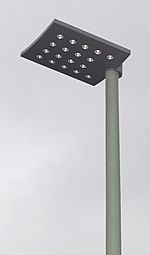
In some cities, street lights use solar panels and supercapacitors. The supercapacitors store the solar energy during the day and power the LED lights all night. They can last over 10 years and work well in very hot or very cold weather.
Medical Uses
Supercapacitors are used in defibrillators, which are devices that deliver an electric shock to help a heart beat normally again. They can deliver a strong burst of 500 joules of energy quickly.
Transport Uses
Aviation
In 2005, a company called Diehl Luftfahrt Elektronik chose supercapacitors to power emergency systems on airliners, including the Airbus A380. They help power things like emergency door openers and evacuation slides.
Military Uses
Supercapacitors are useful in military vehicles like tanks and submarines because they can provide a lot of power quickly. They help start large engines, especially in cold weather, and can extend battery life by handling sudden power demands. They are also used for things like radar systems, laser power, and backup power for airbags in military vehicles.
Cars
Many car companies are looking at supercapacitors. Toyota's Yaris Hybrid-R concept car uses a supercapacitor for quick bursts of power. PSA Peugeot Citroën uses them in their stop-start systems, which turn off the engine when the car stops to save fuel. The supercapacitors help the engine restart faster. Mazda's i-ELOOP system stores energy in a supercapacitor when the car slows down, and then uses that energy to power the car's electrical systems when the engine is off.
Buses and Trams
More than 20,000 hybrid buses use supercapacitors to help with acceleration, especially in China. In 2014, some trams in China started using supercapacitors. They recharge in just 30 seconds at special spots on the tracks and can then run for up to 4 kilometers (about 2.5 miles) on that stored power.
Energy Recovery
One big challenge in transportation is using less energy and reducing pollution. Supercapacitors help by recovering energy when a vehicle brakes, a process called regenerative braking. They can quickly store and release this energy many times, making them perfect for this job.
Trains
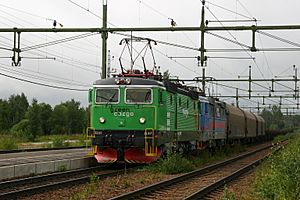
Supercapacitors can help diesel locomotives that use diesel-electric power. They capture the energy from braking and use it to help start the diesel engine and accelerate the train. This can save up to 30% of energy!
Cranes, Forklifts, and Tractors
Large cranes that move shipping containers need a lot of energy to lift them. Supercapacitors can capture energy when the load is lowered, making the cranes more efficient.
Some forklift trucks use supercapacitors along with fuel cells and batteries. The supercapacitors handle the quick power needs, like lifting heavy loads or braking. This can save over 50% of energy compared to regular forklifts.
Supercapacitor-powered terminal tractors (which move containers in warehouses) are a quiet, pollution-free, and cost-effective alternative to diesel tractors.
Light-Rails and Trams
Supercapacitors allow light-rail vehicles to run without overhead lines in historical city areas, which helps preserve the look of the city.
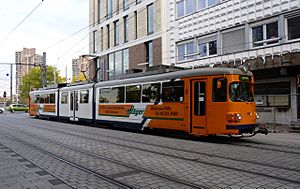
In 2003, the city of Mannheim, Germany, tested a light-rail vehicle that used supercapacitors on its roof. These supercapacitors stored energy from braking. This system could provide 600 kilowatts of power for acceleration and could even drive the vehicle for up to 1 kilometer (about 0.6 miles) without needing power from overhead lines. This saved up to 30% of energy and reduced the demand on the power grid.
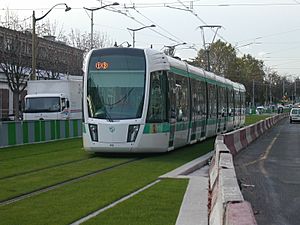
In 2009, supercapacitors allowed trams in Heidelberg, Germany, to operate without overhead wires in the old city. The supercapacitors charge quickly at tram stops.
In 2015, Alstom introduced a system called SRS, which charges supercapacitors on trams using special rails at tram stops. This lets trams run without overhead lines for short distances. This system is used in the Rio de Janeiro Light Rail in Brazil.
Buses
The first hybrid bus in Europe with supercapacitors was tested in Nuremberg, Germany, in 2001. This "Ultracapbus" used a diesel-electric engine with supercapacitors. The supercapacitors captured braking energy and helped with starting. This reduced fuel use by 10 to 15% and also lowered pollution and noise.
In 2005, Shanghai, China, tested a new type of electric bus called a capabus. These buses run without overhead power lines. They recharge quickly at bus stops (under "electric umbrellas") and fully charge at the end of the route. These buses were found to be cheaper than battery buses and much cheaper to run than diesel buses.
Motor Racing
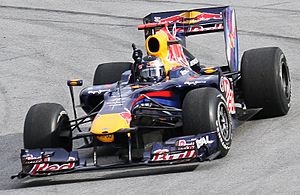
Motor racing organizations like the FIA have looked into using supercapacitors in Formula 1 cars as part of a hybrid system (called KERS). This system helps recover braking energy and gives the car extra power for acceleration.
Racing cars like the Toyota TS030 Hybrid also use supercapacitors. In the famous 2012 24 Hours of Le Mans race, cars with supercapacitors or similar energy storage systems were the fastest because they could charge and discharge energy so quickly for braking and accelerating.
Hybrid Electric Vehicles
Combining supercapacitors and batteries in hybrid electric vehicles (HEVs) is being studied a lot. By recovering braking energy, these vehicles could reduce fuel use by 20 to 60%. Supercapacitors charge much faster than batteries, work well in different temperatures, and last a long time. However, they can be heavier, bigger, and more expensive.
The Mazda 6 is one of the few production cars that uses supercapacitors to recover braking energy. This system, called i-eloop, is said to reduce fuel use by about 10%.
Gondolas
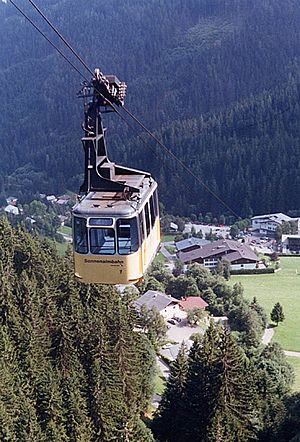
In Zell am See, Austria, an aerial lift (cable car) uses supercapacitors to power the lights, door opening, and communication in the gondolas. Since there's only a very short time to recharge at stations, supercapacitors are perfect because they charge so quickly and last a long time.
The Emirates Air Line (cable car) in London also uses supercapacitors to power the entertainment systems inside its cabins.
Images for kids
-
A micrograph of activated carbon under bright field illumination on a light microscope. Notice the fractal-like shape of the particles hinting at their enormous surface area. Each particle in this image, despite being only around 0.1 mm across, has a surface area of several square meters.
-
A scanning tunneling microscopy image of single-walled carbon nanotube
-
SEM image of carbon nanotube bundles with a surface of about 1500 m2/g
See also
 In Spanish: Supercondensador para niños
In Spanish: Supercondensador para niños


